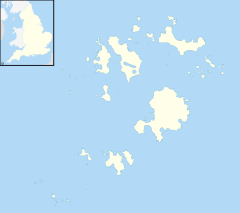Old Blockhouse
| Old Blockhouse | |
|---|---|
| Tresco in the Isles of Scilly | |

Old Blockhouse, viewed from the north-west
|
|
|
Shown within the Isles of Scilly
|
|
| Coordinates |
49°57′31″N 6°19′39″W / 49.95856°N 6.32755°WCoordinates: 49°57′31″N 6°19′39″W / 49.95856°N 6.32755°W grid reference SV897154 |
| Type | Gun tower |
| Site information | |
| Owner | English Heritage |
| Open to the public |
Yes |
| Condition | Ruined |
| Site history | |
| Materials | Granite |
| Events | 1651 invasion of the Scilly Isles |
The Old Blockhouse, also known as the Dover Fort, is a 16th-century fortification on the island of Tresco in the Isles of Scilly. It was built between 1548 and 1551 by the government of Edward VI to protect the islands against French attack.
Overlooking Old Grimsby harbour and the anchorage of St Helen's Pool, the blockhouse would have housed a battery of two or three artillery pieces, positioned on a square gun platform on top of a rocky outcrop. An earthwork bank and a stone wall were built to protect it from attack from the beach and the landward sides respectively. A small room to provide living quarters for the garrison was later constructed on the side of the gun platform.
During the interregnum following the English Civil War, the Old Blockhouse was occupied by the Royalists and it was attacked by the Parliamentary forces of Sir Robert Blake in 1651. Blake's naval guns out-ranged those of the fort, and, after fierce fighting, the blockhouse was taken. A battery of guns was maintained at the blockhouse until at least the 1750s, but by the end of the 18th century the fortification was disused and in ruins.
After 1922 the blockhouse was placed into the guardianship of the state by the lessee of the island, Arthur Dorrien-Smith, and in the 21st century it is controlled by English Heritage and open to tourists. It is protected as a scheduled monument under UK law.
The Old Blockhouse was built between 1548 and 1551 to protect the Scilly Isles against French attack. Tensions with France had grown during the reign of Henry VIII and spilled over into war in 1538. Henry initially responded by fortifying the coasts of England, constructing new artillery forts designed to defend against the longer-range cannons that were becoming common in the 16th century. Henry's son, the nine-year-old Edward VI, inherited the throne in 1547, facing renewed war with France.Edward Seymour was made the Lord Protector to the King, and he appointed his brother, Thomas, as England's Lord Admiral. Thomas inspected the Scilly Isles personally and concluded that they were vulnerable to a French invasion.
...
Wikipedia

